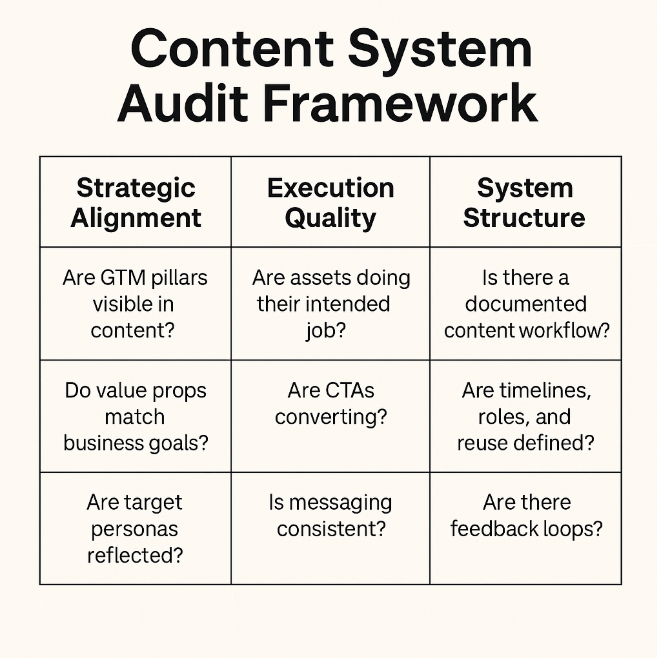How to Evaluate and Evolve a Content Strategy You Didn’t Build
Inherited systems aren’t roadblocks. They’re launchpads.
You won’t always get to build content strategy from the ground up. Often, you're stepping into a system that’s already running, partially implemented, unevenly adopted, or slightly off from the business's real growth goals. This post shows how to approach that moment strategically: by auditing, aligning, and improving without derailing momentum.
Treat auditing as a fast-track to impact, not critique
Focus first on what’s working, and why
Map existing content to buyer journeys and GTM goals
Look for messaging gaps, audience mismatches, and reuse inefficiencies
Evolve before you rebuild. Optimize structure before proposing reinvention.
Why This Is the Most Common Starting Point
Most content strategists aren’t hired to write the GTM strategy. They’re hired after the decks are done and the system is halfway implemented. Messaging pillars might exist. Buyer personas might be defined. Content might be flowing. But the machine isn’t humming yet.
And that’s the moment where strategic content leadership matters most.
You’re not there to scrap everything. You’re there to translate strategy into consistent execution—and identify where the gaps are before they start costing time, alignment, or momentum.
What to Audit First (Without Getting Overwhelmed)
You don’t need a 30-page audit report. But you do need a clear view of what you’ve inherited. I recommend starting with three lenses:
1. Strategic Alignment
Does the content system clearly reflect the GTM strategy?
Can you see pillar themes, value props, and target personas showing up in actual execution?
Or is it a mix of legacy content, internal priorities, and one-off campaigns?
2. Execution Quality
Are the assets doing their jobs?
Do blog posts reinforce belief shifts? Do downloads qualify leads? Are CTAs leading somewhere meaningful?
Where are the underperforming touchpoints, and why?
3. System Structure
Is there an editorial process that connects strategy to production?
Are teams aligned on content goals, timelines, reuse, and measurement?
Or is it a patchwork of ad hoc requests, disconnected campaigns, or siloed distribution?
From here, patterns emerge quickly.
How to Surface Gaps Without Undermining Trust
You’re likely stepping into someone else’s work, or at least a shared foundation. That means your first win isn’t rewriting the strategy. It’s building trust.
Here’s how:
Lead with curiosity, not critique: Ask what the intention behind the current system was. Understand the constraints that shaped it.
Use performance data: Let metrics tell the story. For example: “This white paper is getting good traffic but a low conversion rate. Should we test a CTA variation?”
Identify early wins: Find a small asset or campaign that could be improved with minimal effort and show the impact.
Position your audit as a roadmap: It’s not about pointing out what’s broken. It’s about showing where optimization will drive growth.
From Audit to Action
Once you’ve mapped what exists, the next step is to evolve it.
Refine prioritization: Which content themes or personas need better coverage?
Clarify messaging: Where is the value prop getting lost in translation?
Strengthen structure: Introduce systems for reuse, scheduling, and performance feedback.
Propose pilot improvements: Use one blog pillar or campaign track as your test bed for refinements.
This is where strategy becomes operational. You’re not just analyzing—you’re moving the system forward.
What Content Leaders Should Take From This
Inheriting a content strategy is normal. What matters is how you assess and evolve it.
Strategy isn’t static. Your job is to translate it into execution that actually performs.
Quick wins build trust and create space for deeper improvements.
Auditing is strategy in action. Done well, it becomes the foundation for stronger alignment, better content, and a system that scales.
About Me
I’m a content strategist who builds systems that connect execution to strategy. That includes translating inherited frameworks into high-impact, GTM-aligned content systems that perform, even when the starting point is a little messy. This blog series breaks down what that work really looks like inside a B2B org. Explore the full series.

